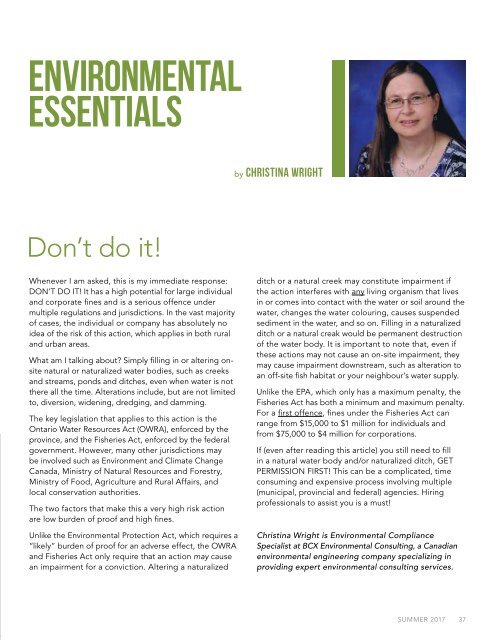ASPHALTopcs | Summer 2017 | VOL 30 | NO 2
You also want an ePaper? Increase the reach of your titles
YUMPU automatically turns print PDFs into web optimized ePapers that Google loves.
ENVIRONMENTAL<br />
ESSENTIALS<br />
by Christina Wright<br />
Don’t do it!<br />
Whenever I am asked, this is my immediate response:<br />
DON’T DO IT! It has a high potential for large individual<br />
and corporate fines and is a serious offence under<br />
multiple regulations and jurisdictions. In the vast majority<br />
of cases, the individual or company has absolutely no<br />
idea of the risk of this action, which applies in both rural<br />
and urban areas.<br />
What am I talking about? Simply filling in or altering onsite<br />
natural or naturalized water bodies, such as creeks<br />
and streams, ponds and ditches, even when water is not<br />
there all the time. Alterations include, but are not limited<br />
to, diversion, widening, dredging, and damming.<br />
The key legislation that applies to this action is the<br />
Ontario Water Resources Act (OWRA), enforced by the<br />
province, and the Fisheries Act, enforced by the federal<br />
government. However, many other jurisdictions may<br />
be involved such as Environment and Climate Change<br />
Canada, Ministry of Natural Resources and Forestry,<br />
Ministry of Food, Agriculture and Rural Affairs, and<br />
local conservation authorities.<br />
The two factors that make this a very high risk action<br />
are low burden of proof and high fines.<br />
Unlike the Environmental Protection Act, which requires a<br />
“likely” burden of proof for an adverse effect, the OWRA<br />
and Fisheries Act only require that an action may cause<br />
an impairment for a conviction. Altering a naturalized<br />
ditch or a natural creek may constitute impairment if<br />
the action interferes with any living organism that lives<br />
in or comes into contact with the water or soil around the<br />
water, changes the water colouring, causes suspended<br />
sediment in the water, and so on. Filling in a naturalized<br />
ditch or a natural creak would be permanent destruction<br />
of the water body. It is important to note that, even if<br />
these actions may not cause an on-site impairment, they<br />
may cause impairment downstream, such as alteration to<br />
an off-site fish habitat or your neighbour’s water supply.<br />
Unlike the EPA, which only has a maximum penalty, the<br />
Fisheries Act has both a minimum and maximum penalty.<br />
For a first offence, fines under the Fisheries Act can<br />
range from $15,000 to $1 million for individuals and<br />
from $75,000 to $4 million for corporations.<br />
If (even after reading this article) you still need to fill<br />
in a natural water body and/or naturalized ditch, GET<br />
PERMISSION FIRST! This can be a complicated, time<br />
consuming and expensive process involving multiple<br />
(municipal, provincial and federal) agencies. Hiring<br />
professionals to assist you is a must!<br />
Christina Wright is Environmental Compliance<br />
Specialist at BCX Environmental Consulting, a Canadian<br />
environmental engineering company specializing in<br />
providing expert environmental consulting services.<br />
SUMMER <strong>2017</strong> 37

















